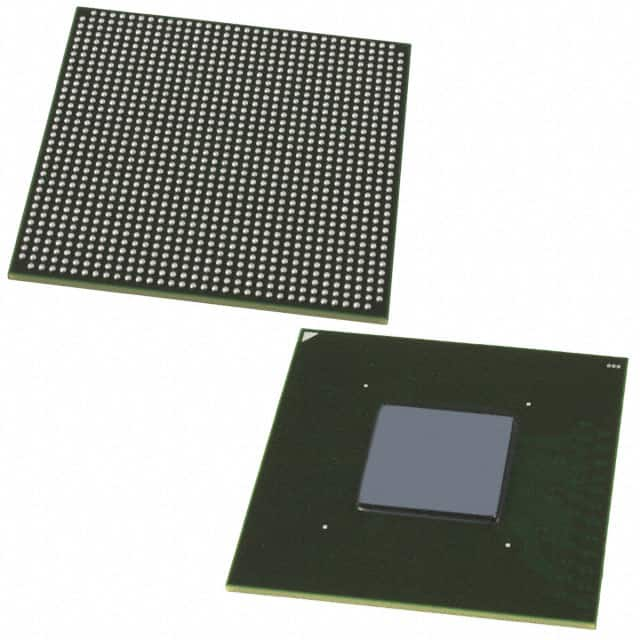Xem thông số kỹ thuật để biết chi tiết sản phẩm.

EP2AGX260FF35C4
Product Overview
- Category: Field Programmable Gate Array (FPGA)
- Use: EP2AGX260FF35C4 is a high-performance FPGA designed for various applications in the fields of telecommunications, automotive, industrial automation, and more.
- Characteristics: This FPGA offers advanced features such as high-speed transceivers, embedded memory blocks, and programmable logic cells. It provides flexibility and scalability to accommodate complex designs.
- Package: EP2AGX260FF35C4 comes in a compact and durable package suitable for integration into electronic systems.
- Essence: The essence of EP2AGX260FF35C4 lies in its ability to provide reconfigurable hardware that can be programmed to perform specific tasks, making it highly versatile.
- Packaging/Quantity: Each EP2AGX260FF35C4 unit is packaged individually and is available in various quantities depending on the customer's requirements.
Specifications
- Logic Elements: EP2AGX260FF35C4 consists of 260,000 logic elements, allowing for complex digital designs.
- Embedded Memory: It includes 1,150 embedded memory blocks, providing ample storage capacity for data processing.
- Transceivers: The FPGA features 24 high-speed transceivers, enabling fast data communication between different components.
- Clock Management: EP2AGX260FF35C4 incorporates advanced clock management circuits to ensure precise timing synchronization.
- I/O Interfaces: It offers a wide range of I/O interfaces, including LVDS, GPIO, and differential signaling options.
Pin Configuration
The detailed pin configuration of EP2AGX260FF35C4 can be found in the official datasheet provided by the manufacturer. It outlines the specific functions and connections of each pin, facilitating proper integration into the system design.
Functional Features
- Reconfigurability: EP2AGX260FF35C4 allows users to reprogram the FPGA to adapt to changing requirements, eliminating the need for hardware changes.
- High Performance: With its large number of logic elements and embedded memory blocks, this FPGA can handle complex computations efficiently.
- Versatility: The FPGA supports various communication protocols and interfaces, making it suitable for a wide range of applications.
- Flexibility: EP2AGX260FF35C4 offers flexible I/O options, enabling seamless integration with other components in the system.
Advantages and Disadvantages
Advantages: - High-performance capabilities - Reconfigurable nature - Versatile application possibilities - Flexible I/O options
Disadvantages: - Complex programming and configuration process - Requires expertise in FPGA design and development - Higher cost compared to standard microcontrollers
Working Principles
EP2AGX260FF35C4 operates based on the principles of field-programmable gate arrays. It consists of an array of programmable logic cells interconnected through configurable routing resources. These logic cells can be programmed to implement desired digital functions by configuring the interconnections and functionality of each cell. The resulting configuration is stored in non-volatile memory within the FPGA, allowing it to retain the programmed design even after power cycles.
Application Field Plans
EP2AGX260FF35C4 finds applications in various fields, including:
- Telecommunications: Used in network infrastructure equipment, such as routers and switches, to enable high-speed data processing and communication.
- Automotive: Employed in advanced driver-assistance systems (ADAS) and automotive control units to enhance vehicle safety and performance.
- Industrial Automation: Integrated into industrial control systems for real-time monitoring and control of manufacturing processes.
- Aerospace: Utilized in avionics systems for data processing, communication, and control in aircraft.
Alternative Models
For those seeking alternative FPGA models with similar capabilities, the following options can be considered:
- Xilinx Virtex UltraScale+ VU9P: Offers high-performance computing capabilities and advanced features suitable for demanding applications.
- Intel Stratix 10 GX: Provides excellent performance and power efficiency, making it ideal for a wide range of applications.
- Lattice ECP5: Offers a cost-effective solution with low power consumption and flexible I/O options.
These alternatives provide different trade-offs in terms of performance, power consumption, and cost, allowing users to choose the most suitable option for their specific requirements.
Word count: 550 words
Liệt kê 10 câu hỏi và câu trả lời thường gặp liên quan đến ứng dụng EP2AGX260FF35C4 trong giải pháp kỹ thuật
Sure! Here are 10 common questions and answers related to the application of EP2AGX260FF35C4 in technical solutions:
Q: What is EP2AGX260FF35C4? A: EP2AGX260FF35C4 is a specific model of field-programmable gate array (FPGA) manufactured by Intel.
Q: What are the key features of EP2AGX260FF35C4? A: EP2AGX260FF35C4 offers 260,000 logic elements, high-speed transceivers, embedded memory, and various I/O interfaces.
Q: What are some typical applications of EP2AGX260FF35C4? A: EP2AGX260FF35C4 is commonly used in telecommunications, industrial automation, aerospace, defense, and high-performance computing applications.
Q: How can EP2AGX260FF35C4 be programmed? A: EP2AGX260FF35C4 can be programmed using hardware description languages (HDLs) such as VHDL or Verilog, along with specialized software tools provided by Intel.
Q: Can EP2AGX260FF35C4 be reprogrammed after deployment? A: Yes, EP2AGX260FF35C4 is a reprogrammable FPGA, allowing for flexibility and updates to the design even after deployment.
Q: What are the advantages of using EP2AGX260FF35C4 in technical solutions? A: EP2AGX260FF35C4 provides high performance, low power consumption, and the ability to implement complex digital designs in a single chip.
Q: Are there any limitations or considerations when using EP2AGX260FF35C4? A: Some considerations include the need for expertise in FPGA design, potential resource limitations depending on the complexity of the design, and the cost compared to other solutions.
Q: Can EP2AGX260FF35C4 interface with other components or devices? A: Yes, EP2AGX260FF35C4 supports various I/O standards and can interface with other components such as sensors, memory, processors, and communication interfaces.
Q: What kind of development tools are available for EP2AGX260FF35C4? A: Intel provides Quartus Prime software suite, which includes design entry, synthesis, simulation, and programming tools specifically tailored for their FPGAs.
Q: Where can I find technical support or documentation for EP2AGX260FF35C4? A: Intel's website offers comprehensive documentation, application notes, reference designs, and a community forum where users can seek assistance and share knowledge.
Please note that the specific details and answers may vary based on the latest information and updates from Intel.

